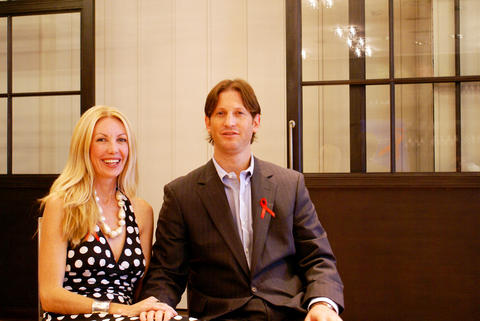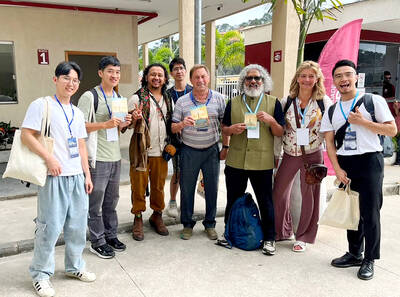They are smart, sexy and committed to each other. She is an activist and editor in chief of a respected New York-based magazine; he is an ex-paratrooper and works for a sports team. She speaks in snappy sentences, a testament to her years on the lecture circuit; he ponders his every utterance, unaccustomed to being in the limelight and hounded with questions. They've been dating for more than a year and have received requests to go on talk shows to discuss their story. But they (or more specifically he) have refused to speak publicly about their relationship - until now.
She is Regan Hofmann, the face of HIV/AIDS in the 21st century and he is Sean Foster, the part of her life that keeps her grounded outside the maelstrom of activism. Together they come across as a typical American couple, a reality they are keen to impress on others in the hope of changing people's perception of the disease.
"Regan is my girlfriend - that's the primary thing," Foster said on Wednesday after attending a press conference at the Lung Ying-tai Cultural Foundation (龍應台文化基金會). "And what comes along with that is HIV/AIDS and I'm going to be with her and involved in this or I'm not going to be with her."

PHOTO: NOAH BUCHAN, TAIPEI TIMES
Foster believes AIDS is a disease much like any other, such as cancer or lung disease. There is no judgment, no shame. Just the knowledge that the woman he loves has a health problem that could potentially be fatal.
"It is a calculated risk. It's not just, 'she has HIV and I'm going to do this for humanity.' It's not like that," Foster said. "It's about personal decisions. I do believe in supporting Regan in the fight that she's in and anything I can do to help, I will."
Hofmann contracted HIV through a heterosexual relationship eleven years ago. Contrary to the commonly held perception that HIV is a virus contracted by homosexuals or intravenous drug users, Hofmann makes it clear that anyone having unprotected sex is at risk.
"It's a sexually transmitted virus," she said. "It comes in through the bloodstream [and] that's nature's choice. If it were airborne there would be no stigma surrounding HIV," she said. Part of Hofmann's mission is altering people's perceptions of HIV by challenging the stigma associated with the disease.
After learning that she had the disease, Hofmann began reading POZ (www.poz.com), a monthly magazine about living with HIV/AIDS. It quickly became her lifeline to information about the virus and the community affected by it.
Six years later she wrote to the magazine stating that she wanted to write an anonymous column about the side effects of the drugs she was taking three times a day, which had the potential to cause a perceptible change in her body's physique, thereby revealing her HIV status.
What started as an occasional article soon blossomed into her own column, still anonymous, about her experiences disclosing her HIV-positive status to family, friends and acquaintances.
"I found that there's no way to predict how someone will react," she once wrote. "If they're calm, they'll freak out later; if they get upset, they'll often show up at your door with a gift and a mouthful of 'sorries' a couple of days down the line."
And how did Foster react when she first told him?
"It made my heart drop. Honestly, I got a sick feeling because I had met a great person," he said. Clearly, however, this did not prove to be an obstacle to their burgeoning relationship.
Though Hofmann was becoming more comfortable about disclosing her condition - she told her family almost immediately after she tested positive and they have been supportive - there were still many times she wouldn't reveal her condition because she couldn't predict how a person would react.
Given the choice, Hofmann would have preferred only to disclose her HIV-positive status to those she was closest to or those who she knew could accept the disease without being judgmental.
Ten years after contracting the virus and four years after publishing her first article in POZ, the magazine called her with a life-changing offer: they wanted her to become the magazine's editor in chief and the cover subject for her first issue - thereby losing her anonymity.
Before accepting the offer, Hofmann wondered whether she was representative of the AIDS community. "I didn't want to come forward as a representative of the community unless I represented a large swath of [that] community," she said.
Further research revealed to Hofmann that she was, in fact, typical of one segment of the HIV/AIDS community that she felt wasn't receiving enough attention. "I remember when I was fact checking I looked at the statistics and I kept asking myself: 'Is this right? Is this right? One in three people infected in the US [are women]? That can't be true. I'd never seen a woman on TV that is HIV positive. Ever.'" She accepted the position.
Her cover article for POZ immediately gained the attention of the news media and turned Hofmann into one of the US' top HIV/AIDS activists overnight. Interviews on The Oprah Winfrey Show and Good Morning America followed, and she wrote articles for women's magazines such as Vogue and Marie Clare.
A new strategy
The strategy employed by Hofmann and POZ is simple: send a positive message rather than one of fear, focus on health rather than disease and emphasize longevity over imminent death.
"It used to be scare tactics, scaring people and talking down to them. Now the messaging is friendlier and more upbeat. It's got to be normalized like that. Otherwise, people aren't even going to watch the commercial," she said referring to public service broadcasts during the 1980s and 1990s that featured heartbreaking images of children with HIV in Africa or emaciated AIDS patients in hospital beds.
"People don't want to talk about AIDS. They don't want to talk with anyone who has AIDS. One of my things is [to] come with a friendly approach, come with an approach that won't scare people away."
To facilitate this softer approach, POZ is the process of creating an online video library of people with AIDES recounting their stories. This approach, says Hoffmann, will be accessible to all ages and social classes
Hofmann sees HIV/AIDES awareness in a larger global context: "This is a humanitarian issues, we have the means to treat and care for and emotionally support to the people living with this disease but we have to individually change the way we see the disease."
She says she admires courageous individuals like Harmony Home Association (
"I don't have a choice. Part of this is people say I'm brave and selfless but in some ways I'm afraid and selfish,' she said.
Still, Hofmann has a choice to do something else and the fact that she is so actively involved has resulted in kudos from all sectors of society.
Marriage and children
Foster and Hofmann are considering taking the next step as their relationship evolved. When asked if they plan on marrying or having children, Hofmann says her main concern is the fact that she is already 40 years old. Foster sees the issue in a different light.
"Regan has an opportunity right now. She has a platform right now to make this effect, have this effect, with the magazine, so it's timing. It's a tough topic because we want to take advantage of all these things at the same time," he said
That the main struggle for Foster and Hofmann is, like for many people their age, the struggle of balancing home life and their career shows how far HIV/AIDS activism has changed the face of the disease over the past 25 years.

Most heroes are remembered for the battles they fought. Taiwan’s Black Bat Squadron is remembered for flying into Chinese airspace 838 times between 1953 and 1967, and for the 148 men whose sacrifice bought the intelligence that kept Taiwan secure. Two-thirds of the squadron died carrying out missions most people wouldn’t learn about for another 40 years. The squadron lost 15 aircraft and 148 crew members over those 14 years, making it the deadliest unit in Taiwan’s military history by casualty rate. They flew at night, often at low altitudes, straight into some of the most heavily defended airspace in Asia.

This month the government ordered a one-year block of Xiaohongshu (小紅書) or Rednote, a Chinese social media platform with more than 3 million users in Taiwan. The government pointed to widespread fraud activity on the platform, along with cybersecurity failures. Officials said that they had reached out to the company and asked it to change. However, they received no response. The pro-China parties, the Chinese Nationalist Party (KMT) and Taiwan People’s Party (TPP), immediately swung into action, denouncing the ban as an attack on free speech. This “free speech” claim was then echoed by the People’s Republic of China (PRC),

Many people in Taiwan first learned about universal basic income (UBI) — the idea that the government should provide regular, no-strings-attached payments to each citizen — in 2019. While seeking the Democratic nomination for the 2020 US presidential election, Andrew Yang, a politician of Taiwanese descent, said that, if elected, he’d institute a UBI of US$1,000 per month to “get the economic boot off of people’s throats, allowing them to lift their heads up, breathe, and get excited for the future.” His campaign petered out, but the concept of UBI hasn’t gone away. Throughout the industrialized world, there are fears that

Like much in the world today, theater has experienced major disruptions over the six years since COVID-19. The pandemic, the war in Ukraine and social media have created a new normal of geopolitical and information uncertainty, and the performing arts are not immune to these effects. “Ten years ago people wanted to come to the theater to engage with important issues, but now the Internet allows them to engage with those issues powerfully and immediately,” said Faith Tan, programming director of the Esplanade in Singapore, speaking last week in Japan. “One reaction to unpredictability has been a renewed emphasis on